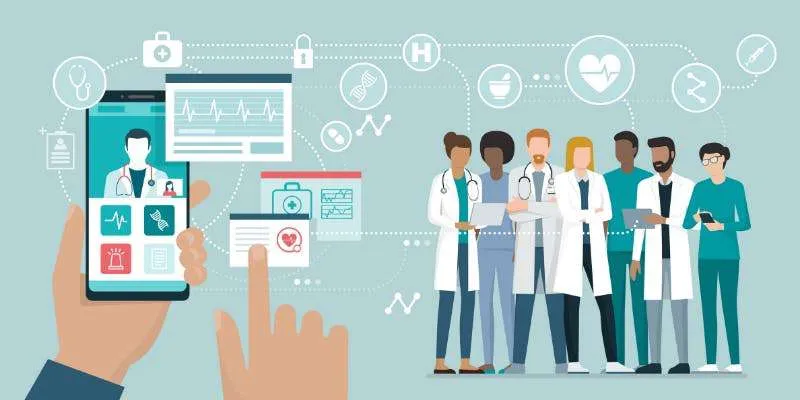How COVID-19 accelerated funding in Indian healthcare sector
Digital health services have existed in the Indian healthcare sector for some time but COVID-19 resulted in a paradigm shift in the segment, leading to lucrative investment opportunities, M&As, and more.
The pandemic-led boost in digital transformation in the Indian healthcare sector has been capturing headlines since last year.
Even the government has taken several steps to build solutions that can help combat the pandemic. As a result, Indian healthcare startups also attracted more funding over the last year.
According to YourStory Research, Indian healthcare startups raised $1.3 billion across 69 deals this year as of August 6, 2021. This is significantly more than the $316 million raised in the whole of 2020 (although the number of deals is fewer compared to 91 deals).

Image Credit: Manash Pratim, YS Design
Additionally, healthtech also saw some big acquisitions this year. In June, healthtech unicorn PharmEasy, acquired a 66.1 percent stake in Thyrocare for Rs 4,546 crore. In the same month, Tata Sons acquired a majority stake in online pharmacy and healthcare startup 1MG Technologies for an undisclosed value.
In an earlier interaction with YourStory, Dr Taslimarif Saiyed, CEO and Director of C-CAMP (Centre for Cellular and Molecular Platform), explained that digitisation capabilities were already being used in the healthcare sector but the pandemic bolstered the shift.
“There was already a trend of bringing digitisation capabilities in healthcare for diagnostics, screening, and other solutions. Using digital or tech in healthcare was already coming in, but not in full force for many reasons including behavioural patterns and resources. But now, with the COVID-19 led circumstances, the shift got accelerated,” he said.
As the healthtech sector continues to grow and develop, these are few key trends we might see post-pandemic in India.
Digital embrace and hybrid model
The COVID-19 pandemic helped doctors and patients realise the importance of virtual consultations and telemedicine services. Amid the fear of contracting the virus, people had to immediately shift to the online platform for checkups and follow-ups.
Not only consultation but even diagnosis has moved online where patients are booking tests and getting them done from their home. However, it could prove to be tough for the entire consultation and diagnosis process to move online.
Thus, going forward, healthtech might operate on a hybrid model where both online and offline services will work together to facilitate access to quality healthcare. While online consultation and telemedicine services can ensure greater penetration across the country, offline partners can offer support in the process.
For example, doctors can remotely monitor patients using wearable devices and send immediate help during an emergency using offline partners.

Image Credit: Manash Pratim, YS Design
Remote care monitoring and home care
According to reports, the doctor-patient ratio in India is 1:1456, compared to WHO recommendation of 1:1000. Amid the pandemic, India has realised that apart from infrastructure development, there is also a need for more healthcare workers to meet the needs of the entire population.
One solution to this issue could be remote care monitoring services. Post consultation and diagnosis, doctors can monitor the health of the patients regularly using smart devices. Startups such as MedRabbits, MyHealthcare, BeatO, among others are working to develop innovative solutions in this space.
In case of any abrupt changes in the vitals of the patients, doctors can immediately check up on them online and send help in case of an emergency.
With an increase in demand for remote monitoring services, home care is also expected to play a big role in healthtech. According to experts, in the future, post-operative care in some cases might be done from home via remote monitoring services.
Increased use of AI, ML, IoT
Technologies such as AI/ML are already being used in healthcare, especially in the diagnosis segment.
Startups such as NIRAMAI, 5C Network, and Predible, among others, have been using deep technologies to ensure prescreening and diagnosis of health conditions amid the pandemic.
People have also realised the importance of maintaining one’s health and staying fit. While earlier, there was a practice of visiting doctors when one falls sick, consumer behaviour during the pandemic has led them to monitor their health closely.
Due to this, people are now not only practising a healthier lifestyle but are also monitoring their health such as vitals, diabetes level, pressure level etc using various smart health devices.
According to a recent report by Data Bridge, the global smart devices market is growing at a CAGR of 20.1 percent to reach $126,409.49 Million by 2028 from $30,084.95 Million in 2020.
Amid the pandemic, several doctors are monitoring COVID-19 patients with low symptoms from their homes. Using IoT devices and mobile applications, doctors are able to receive real-time updates about patients without being near them.

Representational Image
Electronic medical records
People with existing conditions that put them at a higher risk of COVID-19 might also need hospitalisation and may experience severe symptoms.
In such cases, doctors need to have immediate access to a patient’s complete health records to make treatment-related decisions. This has now opened up the dialogue on the need for electronic medical records that can be accessed easily and even remotely at any given point in time.
Apart from helping in making quicker treatment decisions, the stored data will also help in analysing and researching health and disease trends across the country and help people, healthcare institutions, and the government take precautions accordingly.
Personalised care from home
Healthcare needs for people may be different depending upon their genomic structure, previous health conditions, the reaction of medications, etc. Due to this, it is very important to personalise healthcare to meet the needs of the patient.
Post-pandemic, healthcare might become more personalised and patient-centric in nature where each person will receive treatment according to their needs.
While some amount of general care will continue to exist, treatment decisions might be taken depending on the patient’s personal healthcare needs.

Representational Image
Way forward
According to an IAMAI-Praxis report titled ‘HealthTech Predictions 2021’, the Indian healthtech market is growing at a 39 percent CAGR to reach $5 billion by 2023.
It also revealed that government initiatives such as the announcement of Telemedicine Practice Guidelines, National Digital Health Mission (NDHM), and eAccess to healthcare are crucial for the sector.
While digital health services such as teleconsultation, online pharmacy, electronic health records have been available in India for a long time, the adoption among both doctors and consumers was low.
However, the pandemic and lockdowns forced both sides to realise the potential of digital healthcare services.
This digital shift that has the potential to bridge several gaps in the healthcare system is also expected to bring in newer funding opportunities in the sector.
Edited by Saheli Sen Gupta









